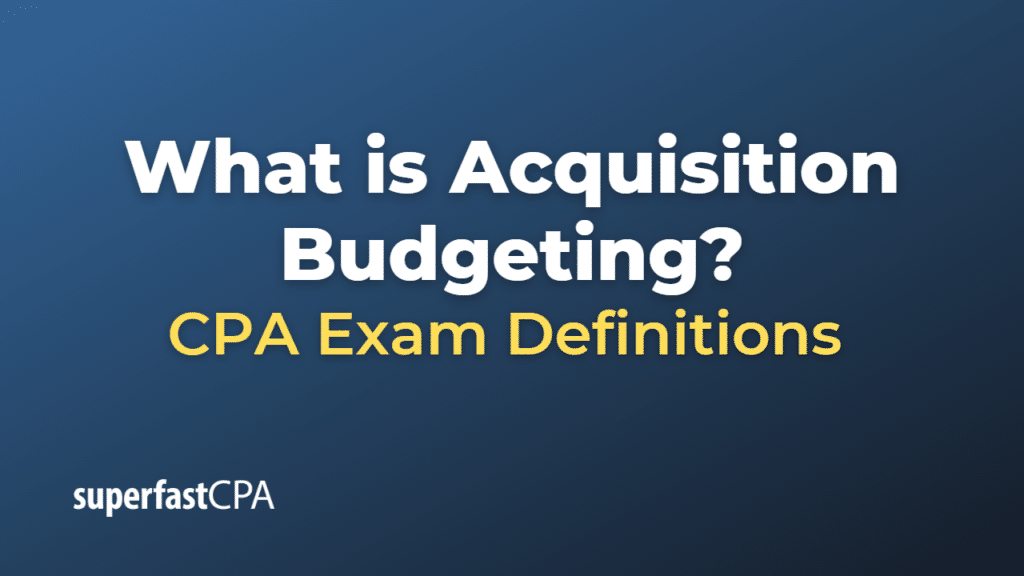Acquisition Budgeting
Acquisition budgeting refers to the process of planning and allocating financial resources for purchasing or acquiring assets, businesses, or other entities. This budgeting process is typically carried out by a company’s management or finance department and helps ensure that the acquisition aligns with the company’s strategic objectives, financial capacity, and risk tolerance.
The acquisition budgeting process generally involves the following steps:
- Setting acquisition goals: Management identifies the strategic objectives and reasons behind the acquisition, such as expanding market share, entering new markets, acquiring new technology, or achieving cost synergies.
- Evaluating potential targets: The company assesses potential acquisition targets based on criteria like strategic fit, financial performance, market position, and growth potential. This step may involve extensive due diligence to gather information about the target and its operations.
- Estimating acquisition costs: The company estimates the total costs associated with the acquisition, including purchase price, transaction fees, integration costs, and any other expenses related to the deal. These costs should be considered in the context of the company’s overall budget and financial capacity.
- Assessing financing options: Management evaluates various financing options for the acquisition, such as using cash reserves, issuing new shares, or obtaining debt financing. The chosen financing mix should align with the company’s capital structure, risk tolerance, and long-term goals.
- Developing a post-acquisition plan: The company creates a plan for integrating the acquired entity into its operations, including management and organizational structure, systems and processes, and culture. This plan should also outline the expected synergies, cost savings, and revenue enhancements resulting from the acquisition.
- Monitoring and adjusting the budget: The company monitors the actual acquisition costs and integration expenses against the budget, making adjustments as necessary to ensure the acquisition stays within the allocated financial resources and delivers the desired results.
Acquisition budgeting is essential for companies pursuing growth through mergers and acquisitions, as it helps them manage the financial aspects of the deal, allocate resources efficiently, and ultimately maximize the value derived from the acquisition.
Example of Acquisition Budgeting
Let’s consider a hypothetical example of a tech company, TechA, that wants to acquire another company, TechB, to expand its product offerings and customer base.
- Setting acquisition goals: TechA identifies that acquiring TechB will allow them to enter new markets, diversify their product offerings, and access a broader customer base. The acquisition aligns with TechA’s long-term growth strategy.
- Evaluating potential targets: TechA performs a detailed analysis of TechB, examining its financial performance, market position, product portfolio, and growth potential. TechA’s management concludes that TechB is a suitable acquisition target due to its complementary products and strong market presence.
- Estimating acquisition costs: TechA estimates the total cost of acquiring TechB, including a purchase price of $50 million, transaction fees of $1 million, and integration costs of $5 million. This brings the total estimated acquisition cost to $56 million.
- Assessing financing options: TechA decides to finance the acquisition using a combination of cash reserves ($20 million), issuing new shares ($20 million), and obtaining a bank loan ($16 million).
- Developing a post-acquisition plan: TechA creates a plan for integrating TechB into its operations, outlining how the two companies’ management teams, organizational structures, and systems will be combined. The plan also includes expected cost synergies, such as consolidating office spaces and streamlining administrative functions, as well as revenue enhancements, like cross-selling products to both companies’ customers.
- Monitoring and adjusting the budget: After the acquisition, TechA closely monitors the actual costs and integration expenses, comparing them to the initial budget. They find that integration costs are higher than anticipated, but by carefully managing other expenses, TechA is able to keep the overall acquisition within the allocated budget. The company adjusts its plans as needed to ensure the acquisition delivers the desired strategic benefits and financial returns.
In this example, TechA’s acquisition budgeting process helps the company plan and manage the financial aspects of the acquisition, allocate resources effectively, and maximize the value derived from the acquisition of TechB.













